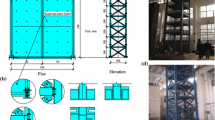Abstract
New approximate formulas are proposed to determine the natural frequencies of structures considering the effects of panel zone flexibility and soil-structure interaction. Several structures with various earthquake resisting systems are idealized as prismatic cantilever flexural-shear beams. Floor masses are considered as lumped masses at each story level and masses of columns are evenly distributed along the cantilever beam. Soil-structure interaction is considered as axial and rotational springs, whose potential energy are formulated and incorporated into overall potential energy of the structure. Subsequently, natural frequency equations are derived on the basis of energy conservation principle. The effect of axial forces on natural frequency is also considered in the proposed formulas. Using the method presented in this study, natural frequencies are computed using a simplified method with no complex numerical modeling. The proposed formulas are verified via experimental and numerical methods. Close agreement between the results from these three approaches are observed. Furthermore, the effects of panel zone flexibility, continuity plates and doubler plates on the natural frequencies of buildings are investigated.
Similar content being viewed by others
References
Auciello NM and Nole G (1998), “Vibrations of a Cantilever Tapered Beam with Varying Section Properties and Carrying a Mass at the Free End,” Journal of Sound and Vibration, 214:105–119.
Charney FA and Pathak R (2008a), “Sources of Elastic Deformations in Steel Frame and Tube Structures. Part 1: Simplified Subassemblage Models,” Journal of Constructional Steel Research, 64(1): 87–100.
Charney FA and Pathak R (2008b), “Sources of Elastic Deformations in Steel Frame and Framed-tube Structures: Part 2: Detailed Subassemblage Models,” Journal of Constructional Steel Research, 64(1): 101–117.
Chen DW and Wu JS (2002), “The Exact Solutions for the Natural Frequency and Modes Shapes of Nonuniform Beams with Multiple Spring Mass Systems,” Journal of Sound and Vibration, 255: 299–322.
Chopra AK (1995), Dynamics of Structures, New Jersey: Prentice-Hall Inc.
Clough RW and Penzein J (1995), Dynamics of Structures, Berkeley: Computer & Structures Inc.
Cowper GR (1966), “The Shear Coefficient in Timoshenko’s Beam Theory,” Journal of Applied Mechanics, 33: 335–340.
Downs WM (2002), “Modeling and Behavior of Beam/column Joint Regions of Steel Frames,” M.S. thesis, Blacksburg (VA): Department of Civil and Environmental Engineering, Virginia Tech.
Firouz-Abadi RD, Haddadpour H and Novinzadeh AB (2007), “An Asymptotic Solution to Transverse Free Vibrations of Variable-section Beams,” Journal of Sound and Vibration, 304: 530–540.
Hibbeler RC (2006), Structural Analysis, New Jersey: Prentice-Hall Inc.
Kassimali A (2009), Structural Analysis, Stanford: Cengage Learning.
Laura PA and Gutierrez (1986), “Vibrations of an Elastically Restrained Cantilever Beam of Varying Cross Sections with Tip Mass of Finite Length,” Journal of Sound and Vibration, 108: 123–131.
Lee WH (2007), “Free Vibration Analysis for Tube-intube Tall Buildings,” Journal of Sound and Vibration, 303: 287–304.
Li QS, Cao H and Li G (1994), “Analysis of Free Vibrations of Tall Buildings,” Journal of Engineering Mechanics, ASCE, 42(9): 1861–1876.
Nagaya K and Hai Y (1985), “Seismic Response of Underwater Members of Variable Cross Section,” Journal of Sound and Vibration, 119: 119–138.
Shong JW and Chen CT (2005), “An Exact Solution for the Natural Frequency and Modes Shapes of an Immersed Elastically Wedge Beam Carrying an Eccentric Tip Mass with Mass Moment of Inertia,” Journal of Sound and Vibration, 286: 549–568.
Türker T, Kartal ME, Bayraktar A and Muvafik M (2009), “Assessment of Semi-rigid Connections in Steel Structures by Modal Testing,” Journal of Constructional Steel Research, 65: 1538–1547.
Wang Q (1996), “Sturm-liouville Equation for Free Vibration of a Tube-in-tube Tall Building,” Journal of Sound and Vibration, 191(3): 349–355.
Author information
Authors and Affiliations
Corresponding author
Rights and permissions
About this article
Cite this article
Ghasemzadeh, H., Samani, H.R. & Mirtaheri, M. Vibration analysis of steel structures including the effect of panel zone flexibility based on the energy method. Earthq. Eng. Eng. Vib. 12, 587–598 (2013). https://doi.org/10.1007/s11803-013-0199-4
Received:
Accepted:
Published:
Issue Date:
DOI: https://doi.org/10.1007/s11803-013-0199-4




